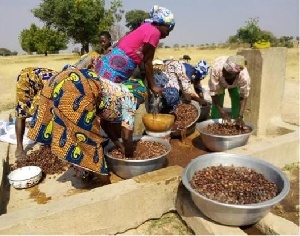Ghana’s Shea Industry Faces Challenges Amid Rising Global Demand
Ghana’s shea nut industry is facing mounting challenges, with production declining steadily over the past decade. Recent data reveals a 10–20% drop in sheanut output, largely due to climate change and worsening environmental conditions.
Production Down, Exports Up
Despite falling yields, shea exports from Ghana have been rising annually, creating concerns about the long-term sustainability and productivity of the local industry. Ghana produces more than 150,000 metric tonnes of shea nuts each year, yet only 30–40% is processed domestically into shea butter. The majority is exported in raw form, mainly to Europe.
During the COVID-19 pandemic in 2020, shea exports dipped to 75,000 metric tonnes valued at US$70 million. However, by 2021, exports had climbed back to 85,000 metric tonnes (US$80 million), and in 2022 surpassed 90,000 metric tonnes, bringing in approximately US$90 million.
Industry Players Call for Export Ban on Raw Nuts
In response to growing concerns, the Ghana Shea Employers Association (GSEA) has called for an immediate ban on raw sheanut exports. At a recent press conference, the association warned that continued exports of unprocessed nuts threaten the survival of local processors and businesses, especially in the Northern Region.
They emphasized the lack of value addition in shea exports and insufficient investment in the shea value chain for Ghanaians. The GSEA urged foreign investors to establish processing plants in Ghana to help boost domestic production and job creation.
Economic Opportunity and Social Impact
Shea nuts are among Ghana’s top non-traditional agricultural exports and are essential to rural livelihoods, especially for women in the north. The sector has the potential to reduce regional inequality and improve incomes for smallholder farmers.
Globally, the market for shea butter—widely used in cooking and cosmetics—is booming. Valued at US$2.75 billion, the market is projected to reach US$5.58 billion by 2033.
However, increased international demand has contributed to local price hikes, squeezing both consumers and producers. For instance, a 2kg bowl of shea nuts sold for GH¢12 in 2023 but rose to GH¢14 in early 2024. Due to interference by middlemen, that same quantity now sells for as much as GH¢60.
Although COCOBOD oversees commodity pricing, it has done little to curb price volatility or regulate middlemen, leaving shea nut pickers vulnerable to exploitation.
Lack of Institutional Support
Unlike cocoa farmers, shea producers receive minimal support, with no structured incentives or government-backed programs to expand cultivation and processing. This lack of support has left the local industry underdeveloped, even as global demand surges.
Climate Change and Environmental Threats
Climate change poses a major threat to the shea sector. Rising temperatures in northern Ghana are not only reducing yields but also triggering health crises like Cerebrospinal Meningitis (CSM) and killing off shea trees.
Erratic rainfall and prolonged droughts have disrupted farming seasons, leading to food shortages and inflation. These challenges are worsened by failed irrigation initiatives such as the One Village, One Dam program, which has suffered from poor execution, with many dams drying up shortly after the rainy season.
Farmers now face up to six months without rain annually, resulting in long periods of economic inactivity and hardship. Many are forced to spend limited earnings on basic necessities after climate shocks wipe out their harvests.
Shea trees, which take about 10 years to bear fruit and reach full maturity in 20 years, can live for up to 300 years. Yet, rising temperatures and deforestation are putting their survival at risk.
Cultural and Environmental Hurdles
Deep-rooted cultural myths also limit shea cultivation. In some communities, planting shea trees is believed to bring death once they bear fruit—leading to heavy dependence on wild shea trees rather than systematic farming.
Meanwhile, unregulated harvesting and environmental degradation are threatening biodiversity and worsening the impacts of climate change in savannah regions. These landscapes have high carbon storage potential, making them critical to global climate mitigation efforts.
Limited Impact of Restoration Projects
Although the Green Climate Fund has backed a project to restore degraded savannah forests, its impact has been minimal. Nearly five years into its implementation, progress remains limited with only three years left before the project’s deadline.
According to COCOBOD, Ghana’s savannah areas are home to around 94 million viable shea trees, while the entire West African region hosts approximately one billion. Without better policy, investment, and education, this vast potential may remain untapped.



